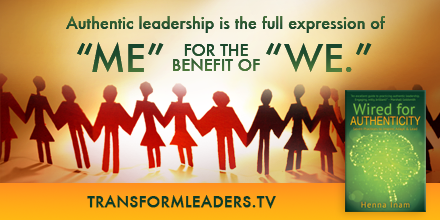 Welcome to Week 7 of the Authenticity@Work Leadership Tool-kit! My intention for this series is to share a quick tool each week to help you lead with more authenticity, adaptability and inspiration so we can together create workplaces where we bring the best of ourselves and inspire others. So grab a journal and an accountability partner to make these practices even more powerful for you!
Welcome to Week 7 of the Authenticity@Work Leadership Tool-kit! My intention for this series is to share a quick tool each week to help you lead with more authenticity, adaptability and inspiration so we can together create workplaces where we bring the best of ourselves and inspire others. So grab a journal and an accountability partner to make these practices even more powerful for you!
In last week’s post we discussed the danger of just being yourself. Did you find situations where “just being yourself” could undermine your leadership impact?
We aren’t who we think we are. What do I mean by that?
There are parts we have that are hardwired. Other parts of us are continually changing and evolving. Both are responsible for who we are – our hardwiring and our softwiring.
HARDWIRING: The fundamental parts of our DNA – our factory settings at birth. Human brains are hardwired to respond to emotion before reason and to classify and categorize information. Many of us also seem to be born with certain innate talents (athletics, music, language, and art) that make achievement in these areas easier.
SOFTWIRING: Our softwiring comes from our experience. Our brains develop shortcuts from our experiences that drive our preferences. Our early experiences literally formed our brain wiring, creating pathways that helped us categorize experiences based on whether they resulted in pleasure or pain. Rewarded behavior as children created neural pathways in our brains that created habitual patterns of who we think we are.
Our identity is important to us, as it gives us a way to see ourselves, to connect with others like us, and to belong. The trouble is when our identity starts to limit us and how we perceive our self-worth, becoming attached to who we should be and who we should not be based on what was rewarded in the family we grew up in.
Attachment to these labels can limit our adaptability to change, prevent us from thinking outside the box and prevent us from creating inclusive cultures.
These labels make up the outer core of our identity, but they are not who we are. At our core is the authentic self. The authentic self is the one that can observe the labels we are attached to. It is the conscious awareness that helps us grow, evolve, adapt, and choose who we are being in any given moment.
This Week’s Tool:
Pick a habitual behavior and consciously intensify the practice of it. In my case, this might be being perceived as the smartest person in the room. Unconsciously, I may do this to be admired by others. In this experiment, I would double up my efforts to be smart and then notice the impact on others. Am I getting admiration, or is it having a different impact? This experiment may have you really experience how what you assume to be “good behavior” can also backfire.
Try stepping out of one of your labels and taking in the opposite perspective. Notice any discomfort you feel when taking on an opposite perspective. What impact does this have on you and your interactions with others?
What did you discover? Join our Authenticity@Work community and post your reflections directly to the blog here (link to this week’s blog).
Get the latest resources for Authenticity@Work (this tab will get updated with all kinds of cool resources). Curious to know more about the book? Read the reviews about Wired for Authenticity here.


We can only discover through exploration in our life journey. At most we develop behaviors that are conditioned by the environment of our upbringing. The development of character and behaviors occur within the period of 2 years to 15 years of age which are locked in out Subconscious mind.Our responses in every aspect of our life is derived from it either consciously or unconsciously. This is life at its best. God Bless As Always. Cheers! Ovia Morea.